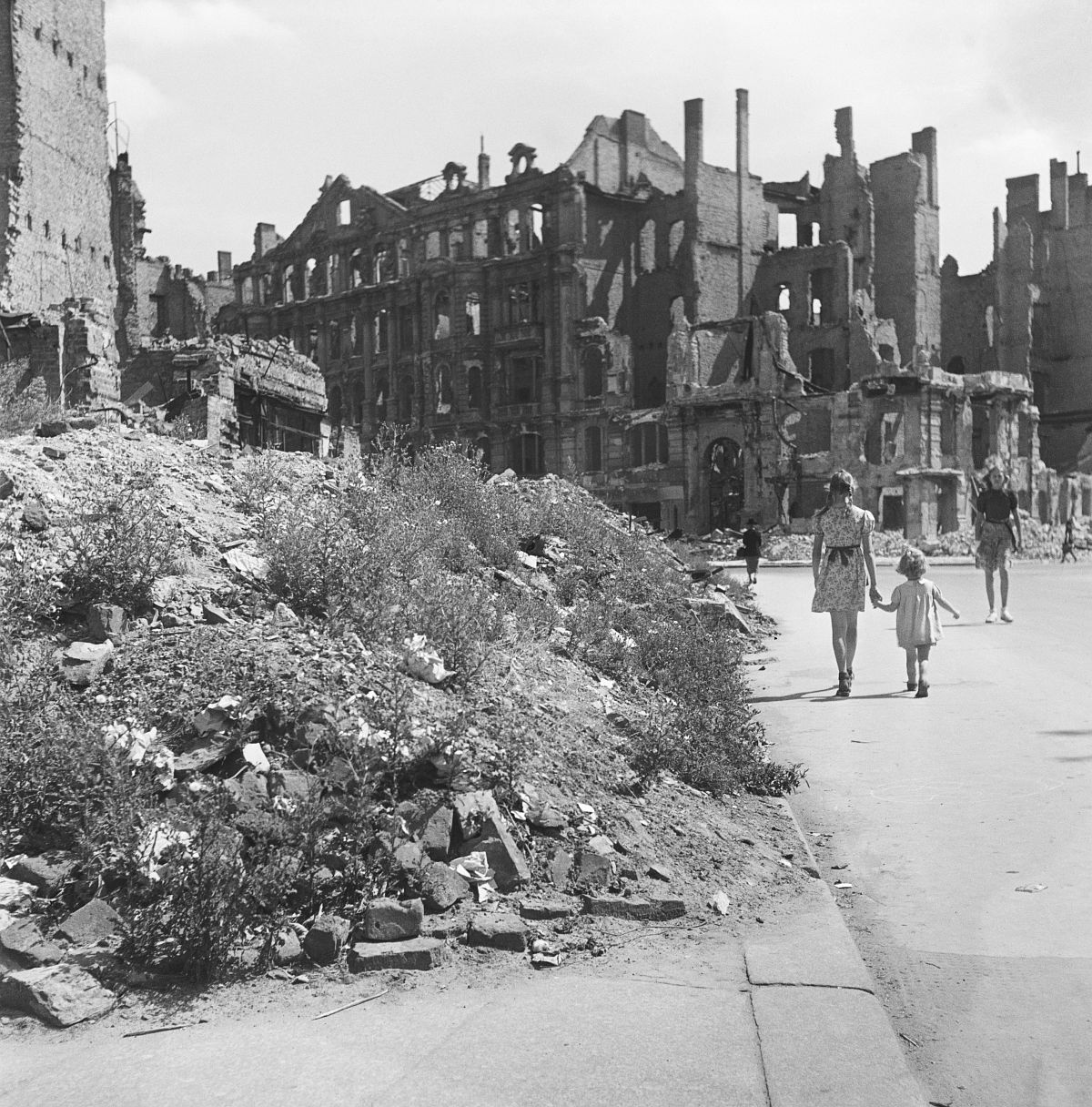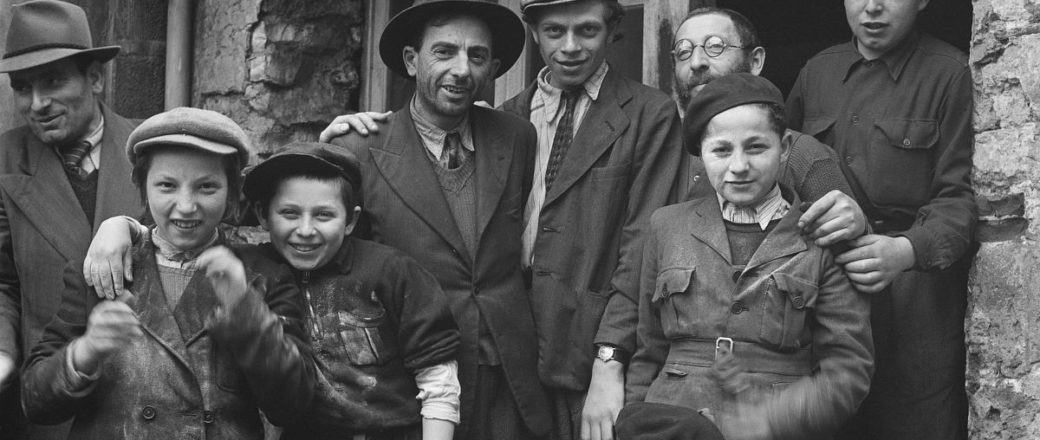Roman Vishniac (1897 – 1990) was a Russian-American photographer, best known for capturing the culture of Jews in Central and Eastern Europe before the Holocaust.
Beginning in 1914, Vishniac spent six years at Shanyavsky Institute (now University) in Moscow. While enrolled there, he served in the Tsarist, Kerensky and Soviet armies. He earned a Ph.D. in zoology and became an assistant professor of biology at the Institute. As a graduate student, he worked with prestigious biologist Nikolai Koltzoff, experimenting with inducing metamorphosis in axolotl, a species of aquatic salamander. While his experiments were a success, Dr. Vishniac was not able to publish a paper detailing his findings due to the chaos in Russia and his results were eventually independently duplicated. In spite of this, he went on to take a three-year course in medicine.
In 1918, the Third Russian Revolution triggered a rise in anti-Semitism that caused Vishniac’s immediate family to relocate to Berlin. He followed soon after and married Luta (Leah) Bagg. They had two children, Mara and Wolf. Vishniac worked various jobs in order to support his family. In his spare time, he studied Far Eastern Art at the University of Berlin, researched endocrinology and optics, and took some photography. It was also during this time that Vishniac began his public speaking career by joining the Salamander Club, where he gave lectures on naturalism.
Between 1935 and 1939, as anti-Semitism was growing in Germany, Vishniac traveled to Eastern Europe and took his acclaimed photographs of the culture of poor Jews in mountainous villages and urban ghettos. At first commissioned by the American Jewish Joint Distribution Committee as part of a fundraising initiative, Vishniac was so affected by the project that he chose to continue it even after the commission was complete. He traveled to the ghettos of Russia, Poland, Romania, Czechoslovakia, and Lithuania for years after he worked for the Committee. Aware of Hitler’s mission to exterminate the Jews, Vishniac was intent on preserving the memory of the Jewish people. He also hoped to promote awareness of the atrocities that were occurring in Nazi territories. In late 1938, Vishniac sneaked into Zbaszyn, an internment camp in Germany near the border, where Jews awaited deportment to Poland. After photographing the “filthy barracks” for two days, he escaped. Vishniac then submitted his photographs to the League of Nations as proof of the existence of such camps.
In order to take the more than 16,000 photographs of Eastern European Jewry, Vishniac used a hidden camera, both to avoid charges of spying and because many Orthodox Jews would not have their picture taken. He was arrested eleven times during this time for taking pictures, often because he was thought to be spying. Vishniac managed to preserve 2,000 of these photographs, hidden by himself and his family and smuggled into America by Walter Bierer through Cuba. The surviving photographs would later be showcased as part of one-man shows at Columbia University, the Jewish Museum, the International Center of Photography, as well as at some other institutions.
While visiting Paris in 1940, Vishniac was arrested by the Pétain police for being a “stateless person,” and was interned at Camp du Ruchard, a deportation camp in Clichy, France. He stayed there for three months until his wife was able to obtain visas for the family to move to the United States. His parents remained in Europe. Vishniac’s mother died from cancer in 1941 and his father spent the war in hiding in France. Vishniac sewed some of his negatives into his clothing when he came to America, but his father hid the bulk of the surviving negatives with him in France.
![Roman Vishniac, [Jewish schoolchildren, Mukacevo], ca. 1935–38. Gelatin silver print. © Mara Vishniac Kohn, courtesy International Center of Photography.](https://monovisions.com/wp-content/uploads/2017/07/roman-vishniac-city-life-photographer-01.jpg)
Roman Vishniac, [Jewish schoolchildren, Mukacevo], ca. 1935–38. Gelatin silver print. © Mara Vishniac Kohn, courtesy International Center of Photography.
![Roman Vishniac, [Interior of the Anhalter Bahnhof railway terminus, near Potsdamer Platz, Berlin], late 1920searly 1930s. © Mara Vishniac Kohn. Courtesy International Center of Photography.](https://monovisions.com/wp-content/uploads/2017/07/roman-vishniac-city-life-photographer-14.jpg)
Roman Vishniac, [Interior of the Anhalter Bahnhof railway terminus, near Potsdamer Platz, Berlin], late 1920searly 1930s. © Mara Vishniac Kohn. Courtesy International Center of Photography.
![Roman Vishniac, [Boys exercising in the gymnasium of the Jewish Community House of Bensonhurst, Brooklyn], 1949. Gelatin silver print. © Mara Vishniac Kohn, courtesy International Center of Photography.](https://monovisions.com/wp-content/uploads/2017/07/roman-vishniac-city-life-photographer-09.jpg)
Roman Vishniac, [Boys exercising in the gymnasium of the Jewish Community House of Bensonhurst, Brooklyn], 1949. Gelatin silver print. © Mara Vishniac Kohn, courtesy International Center of Photography.
![Roman Vishniac, [Customers waiting in line at a butcher’s counter during wartime rationing, Washington Market, New York], 1941–44. Ink-jet print. © Mara Vishniac Kohn, courtesy International Center of Photography.](https://monovisions.com/wp-content/uploads/2017/07/roman-vishniac-city-life-photographer-08.jpg)
Roman Vishniac, [Customers waiting in line at a butcher’s counter during wartime rationing, Washington Market, New York], 1941–44. Ink-jet print. © Mara Vishniac Kohn, courtesy International Center of Photography.
![Roman Vishniac, [Sisters Marion, Renate, and Karen Gumprecht, refugees assisted by the National Refugee Service (NRS) and Hebrew Immigrant Aid Society (HIAS), shortly after their arrival in the United States, Central Park, New York], 1941. Ink-jet print. © Mara Vishniac Kohn, courtesy International Center of Photography.](https://monovisions.com/wp-content/uploads/2017/07/roman-vishniac-city-life-photographer-07.jpg)
Roman Vishniac, [Sisters Marion, Renate, and Karen Gumprecht, refugees assisted by the National Refugee Service (NRS) and Hebrew Immigrant Aid Society (HIAS), shortly after their arrival in the United States, Central Park, New York], 1941. Ink-jet print. © Mara Vishniac Kohn, courtesy International Center of Photography.
![Roman Vishniac, [Holocaust survivors gathering outside a building where matzoh is being made in preparations for the Passover holiday, Hénonville Displaced Persons’ Camp, Picardy, France], 1947. Ink-jet print. © Mara Vishniac Kohn, courtesy International Center of Photography.](https://monovisions.com/wp-content/uploads/2017/07/roman-vishniac-city-life-photographer-06.jpg)
Roman Vishniac, [Holocaust survivors gathering outside a building where matzoh is being made in preparations for the Passover holiday, Hénonville Displaced Persons’ Camp, Picardy, France], 1947. Ink-jet print. © Mara Vishniac Kohn, courtesy International Center of Photography.

Roman Vishniac, The streets are free of brown battalions!, Berlin, 1947. Ink-jet print. © Mara Vishniac Kohn, courtesy International Center of Photography.
![Roman Vishniac, [Boy standing on a mountain of rubble, Berlin], 1947. Ink-jet print. © Mara Vishniac Kohn, courtesy International Center of Photography.](https://monovisions.com/wp-content/uploads/2017/07/roman-vishniac-city-life-photographer-04.jpg)
Roman Vishniac, [Boy standing on a mountain of rubble, Berlin], 1947. Ink-jet print. © Mara Vishniac Kohn, courtesy International Center of Photography.
![Roman Vishniac, [Ernst Kaufmann, center, and unidentified Zionist youth, wearing clogs while learning construction techniques in a quarry, Werkdorp Nieuwesluis, Wieringermeer, The Netherlands], 1939. Ink-jet print. © Mara Vishniac Kohn, courtesy International Center of Photography.](https://monovisions.com/wp-content/uploads/2017/07/roman-vishniac-city-life-photographer-03.jpg)
Roman Vishniac, [Ernst Kaufmann, center, and unidentified Zionist youth, wearing clogs while learning construction techniques in a quarry, Werkdorp Nieuwesluis, Wieringermeer, The Netherlands], 1939. Ink-jet print. © Mara Vishniac Kohn, courtesy International Center of Photography.
![Roman Vishniac, [Zionist youth building a school and foundry while learning construction techniques, Werkdorp Nieuwesluis, Wieringermeer, The Netherlands], 1939. Gelatin silver print. © Mara Vishniac Kohn, courtesy International Center of Photography.](https://monovisions.com/wp-content/uploads/2017/07/roman-vishniac-city-life-photographer-02.jpg)
Roman Vishniac, [Zionist youth building a school and foundry while learning construction techniques, Werkdorp Nieuwesluis, Wieringermeer, The Netherlands], 1939. Gelatin silver print. © Mara Vishniac Kohn, courtesy International Center of Photography.
![Roman Vishniac, [Sara, sitting in bed in a basement dwelling, with stenciled flowers above her head, Warsaw], cs. 1935–37. Platinum print. © Mara Vishniac Kohn, courtesy International Center of Photography.](https://monovisions.com/wp-content/uploads/2017/07/roman-vishniac-city-life-photographer-13.jpg)
Roman Vishniac, [Sara, sitting in bed in a basement dwelling, with stenciled flowers above her head, Warsaw], cs. 1935–37. Platinum print. © Mara Vishniac Kohn, courtesy International Center of Photography.
![Roman Vishniac, [David Eckstein, seven years old, and classmates in cheder (Jewish elementary school), Brod], ca. 1938. Gelatin silver print. © Mara Vishniac Kohn, courtesy International Center of Photography.](https://monovisions.com/wp-content/uploads/2017/07/roman-vishniac-city-life-photographer-12.jpg)
Roman Vishniac, [David Eckstein, seven years old, and classmates in cheder (Jewish elementary school), Brod], ca. 1938. Gelatin silver print. © Mara Vishniac Kohn, courtesy International Center of Photography.
![Roman Vishniac, [Preparing food in a Jewish soup kitchen, Berlin], mid–to late 1930s. Gelatin silver print. © Mara Vishniac Kohn, courtesy International Center of Photography.](https://monovisions.com/wp-content/uploads/2017/07/roman-vishniac-city-life-photographer-10.jpg)
Roman Vishniac, [Preparing food in a Jewish soup kitchen, Berlin], mid–to late 1930s. Gelatin silver print. © Mara Vishniac Kohn, courtesy International Center of Photography.
![Roman Vishniac, [Boy with kindling in a basement dwelling, Krochmalna Street, Warsaw], ca. 1935–38. Gelatin silver print. © Mara Vishniac Kohn, courtesy International Center of Photography.](https://monovisions.com/wp-content/uploads/2017/07/roman-vishniac-city-life-photographer-11.jpg)
Roman Vishniac, [Boy with kindling in a basement dwelling, Krochmalna Street, Warsaw], ca. 1935–38. Gelatin silver print. © Mara Vishniac Kohn, courtesy International Center of Photography.






